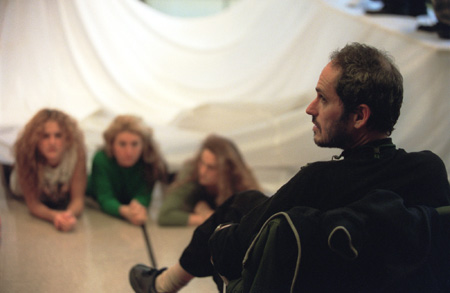‘Marat/Sade’ revived at Loeb
Daring director meets dark Tony Award-winning 1965 play

An asylum full of lunatics and their brutal keepers take over the main stage of the Loeb Drama Center tomorrow night (Feb. 15). It’s a theatrical experience that may give you nightmares, but you’ll also find yourself whistling the catchy tunes.
“The Persecution and Assassination of Jean-Paul Marat as Performed by the Inmates of the Asylum of Charenton, France, under the Direction of Monsieur de Sade” (more familiarly known by its abbreviated title, “Marat/Sade”) first played Broadway in 1965, becoming the most talked-about production of the season and the winner of a Tony Award.
Written by German playwright Peter Weiss, the play takes off from a historical premise. From 1803 to his death in 1814, the Marquis de Sade was imprisoned in the asylum at Charenton, France, for his scandalous writings. There he passed the time by writing and directing plays with his fellow inmates as actors.
In Weiss’ play within a play, de Sade stages the 1793 assassination of the revolutionary leader Marat by a young provincial woman, Charlotte Corday. Thus, the actors have the doubly challenging job of playing a group of mentally ill social misfits impersonating real historical figures. Nevertheless, the dialogue between Marat and de Sade creates a very real tension between two opposing points of view – direct action on behalf of the downtrodden versus a cynical rejection of society and the pursuit of sensual pleasure for its own sake.
The American Repertory Theatre’s (A.R.T.) production promises to be a spectacular one. With a cast of 28, including the entire 2002 class of the A.R.T.’s Institute for Advanced Theater Training, this production should have no trouble generating the sort of chaotic, in-your-face energy that galvanized audiences during an era of political protest and countercultural frenzy.
The huge cast will have an impressive space in which to enact this intense, multileveled drama. The set, designed by Riccardo Hernandez, features an enormous steel cage suspended above the floor and a huge tricolor flag, which assumes a variety of functions during the production.
The director is János Szász, whose 2001 A.R.T. production of Bertolt Brecht’s “Mother Courage” was called “daring theater” by Patti Hartigan in the Boston Globe. “The staging hits you right across the face and then stuns you even further with its mix of gentleness and brutality,” she wrote. It may be that Szász will achieve a similar impact with “Marat/Sade.”
The two plays bear a certain resemblance. Both are by Germans, both use music to comment on and intensify the action, and both present a decidedly dark vision of human existence – Brecht by focusing on the horror of war and Weiss by setting his play among society’s wretched castoffs.
“Most of the plays I have done are dark,” Szász said. “It doesn’t mean that I myself am dark. But I am attracted to dark subjects.”
Szász was born in Hungary and studied drama at the Academy of Theatre and Film Art in Budapest. Well known in Europe for both his theater and film work, he was recently named director of the Institute for Advanced Theatre Training at Harvard.
It is not only the darkness of “Marat/Sade” that attracted Szász, but also the play’s inherent risks.
“It is a drama set in an asylum. All the actors are inmates. This means the actors have to act badly, and many times I have to be a bad director. We have to create a good shape, and then we have to ruin it.”
To help the actors endow their “bad” performances with a note of authenticity, Szász had them view “Titicut Follies,” the 1967 Frederick Wiseman documentary made at Bridgewater State Prison for the Criminally Insane. As the cast developed their characters, they received further guidance from Psychiatrist Philip Freeman, who made several visits to the set to answer the actors’ questions about different kinds of mental illness and the behaviors associated with them.
Student dramaturg Helen Shaw provided further help by supplying the cast with background material on the French Revolution, political and social conditions in 1808 when the play takes place, and on the life and works of de Sade.
In most cases, the text of the play gives little or no indication of what is actually wrong with each character. Szász took this absence of information as an opportunity to give the actors a chance to decide for themselves.
“I like to let my actors improvise and then build on that. I believe it is best to work based on a sense of trust.”
For the actors, this process has been one of introspection as well as observation. Sarah Douglas, who plays the part of Rossignol, spoke about Szász’s approach to creating believable characters.
“He’s discouraged any kind of mimicry, but rather encouraged us to look into our own personalities and to make simple choices out of our own experience,” she said.
Rossignol, one of the few characters whose background is indicated in the play, is an alcoholic ex-prostitute who has traded the mean streets of Paris for the meaner corridors of Charenton. She is also one of a quartet of voices who function as a sort of Greek chorus in the play. Like many of the cast members, Douglas has discovered that spending long hours in rehearsal learning to act like an inmate of a 19th century French insane asylum can take its toll psychologically.
“We joke about it, but it gets to be pretty heavy,” she said. “Spending so many hours in rehearsal every day, you realize that you’re not too far from these people. That can be disturbing, but also enlightening.”
Disturbing and also enlightening is what the play promises to be for its audience as well.
Through March 17. See Calendar listings for times and ticket prices.




